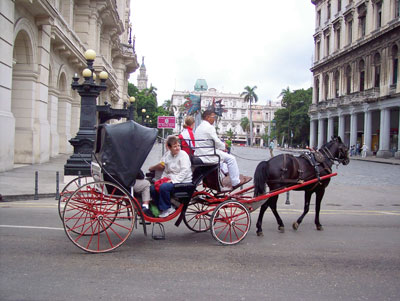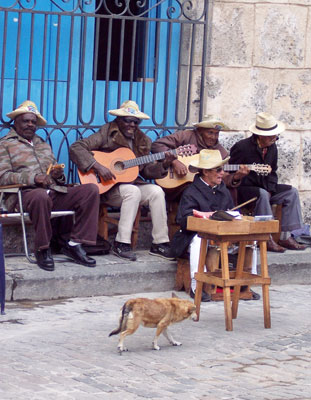Havana to Cienfuegos
This item appears on page 61 of the June 2010 issue.
by Randy Keck (Second of three parts on Cuba. Part one, in the May 2010 issue, thoroughly explored the legal considerations for Americans considering traveling to Cuba.)
Havana — lost in time
The most accurate way to describe Havana and Cuba in general is with two words: time warp. This haunting reality was ever present during my 12-day January ’10 Cuba tour, which was hosted by Toronto-based ElderTreks (800/741-7956, www.eldertreks.com), an ITN advertiser. Their website offers a full description of the itinerary our group of 16 experienced, “Cuba: the Pearl of the Antilles.”
Our Havana accommodation, the famed, historic Hotel Nacional de Cuba, provided an ideal introduction to the city’s architectural bounty of magnificent buildings dating from the 18th century to the 20th. The Nacional is the preferred venue for most foreign first-time visitors to Havana and therefore is usually quite full.
There we began to get to know our invaluable tour leader, Claudio, and our excellent local Cuban guide, Alex, who would be with us for our entire tour. We prepped for an adventurous, fast-paced itinerary featuring continuous opportunities to interact with the Cuban people.
Old Havana on foot
Our first morning in Havana began with a visit to a sparsely supplied local produce market — a somewhat somber introduction to the marginal economic realities faced by the majority of Cubans today. We were informed about the government’s food-rationing system, which exercises controls concerning the amount and types of food available.
Later, a comprehensive walking tour of Old Havana included the Plaza de Armas (the birthplace of Havana) and the colorful Plaza de San Francisco.
This region of Old Havana has been designated a UNESCO World Heritage Site and, as a result, is undergoing significant restoration. The combination of the beautiful, lost-in-time architecture and our first up-close infusion of the famous 1950s classic American autos that abound in Havana and throughout Cuba created digital shutter frenzy.
Our evening in Old Havana was quite special, beginning with dinner at the Ambos Mundos Hotel, where Ernest Hemingway used to keep a room in the 1930s.
Later, the rain ceased just in time for us to put on our dancing shoes. On the outdoor patio rooftop of a modest private home owned by Elsa Maria, a local bandleader, we learned most of the traditional Cuban dance steps, with music supplied by a talented neighborhood band.
Even the shy were enticed by the rhythms fueled by continuous-flow mojitos, the traditional mint-infused Cuban rum cocktail which was omnipresent throughout our tour.
Westward to Pinar del Rio
After visiting austere Revolution Square the following morning, we departed Havana for the alluring Cuban countryside, westward to Pinar del Rio and the UNESCO Biosphere Reserve of Sierra del Rosario.
We visited an artists’ colony and the ruins of a coffee plantation and enjoyed a guided botanical walk on which we learned much about the local flora, including the medicinal uses of numerous plants.
Our hilltop hotel, Los Jazmines, overlooking the valley of Viñales, provided expansive views of lush tobacco fields and other agricultural riches, punctuated by mogotes, or unique, boulder-like hills that abound on the valley floor.
Tobacco is king
Day four began by visiting a small tobacco farm owned and hand tilled by Señor Alfredo. We learned about the tobacco-growing and -production process while having a nonchoreographed, behind-the-scenes look at the rigors of life in today’s rural Cuba. We were invited to ask any and all questions and were the beneficiaries of rum-soaked cigars hand rolled by Señor Alfredo.
The day also featured the Indian Caves, which we had the chance to explore both on foot and by small boat, plus a lunch in the mountains featuring piña coladas — magnifico!
Zapata marshlands and Playa Larga
The following morning we visited the small botanical garden of Caridad, operated by an elderly widow, and enjoyed an informative guided walk.
Then began a long drive eastward to another biosphere reserve, Zapata National Park, reputed to be the best-preserved wetlands in the Caribbean.
On arrival, we had a relaxing although rather uneventful cruise on the Rio Hatiguanico, a prime bird-watching and crocodile habitat. To compensate, there was an interactive experience at a crocodile farm the following day. After the cruise, we continued on to the coast and an overnight at Hotel Playa Larga.
In the evening, we all were “Canadian” guests for a musical performance at the nearby government-sponsored Korimacao Cultural Project, a multifaceted arts academy featuring theater, music, dance and literary pursuits. This is near the site of the Bay of Pigs, a region where hardcore Revolutionista philosophies remain prominent still.
Just after dawn the next morning, I enjoyed a swim in the clear, warm, gentle sea at Playa Larga, with the pristine beach all to myself. Later I met a Canadian fisherman, who advised that the area flats are classified as a world-class bonefish habitat.
After breakfast, a visit to the Bay of Pigs, site of the historic failed invasion and now one of Cuba’s premier diving locations, provided further Revolution-related education.
Cienfuegos — a city apart
Beautiful Cienfuegos (population 150,000) is considered to be Cuba’s best-preserved city. Founded in 1819, some of its architecturally diverse neoclassical buildings grace Plaza Marti in the city center.
After our introductory briefing from the city historian, we visited a local school, where we were thoroughly informed about the impressive national education system in Cuba. The country has a full literacy program, which has long been a high priority for the Cuban government.
The system is competitive, and successful students earn opportunities to matriculate to university and specialist vocational schools and institutes. All this is accomplished, amazingly, without the general population having any access to the Internet. In a second grade classroom, we were entertained by smiling innocents, who sang for us in Spanish and English.
A bit later we dropped in at a casa de abuelos (senior center), where members spend their days engaging in social and educational activities, including excursions, before returning to their family homes in the evening. The cost for this is about US$1 per month, including healthy meals and medical attention.
Our historic Cienfuegos abode, the centrally located Hotel La Union, featured entrancing architecture and a rooftop deck and was the nicest hotel on our Cuba journey.
In the last part of this series, I report on the portion of our tour from Trinidad to Havana.
Keck's Beyond the Garden Wall
❝A land apart where time stands still,
where immunity to the outside world
reflects essence devoid of pretension ❞
— Randy reflecting on life in rural Cuba, essentially isolated from the outside world


